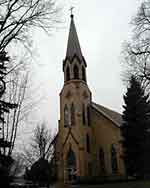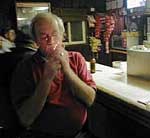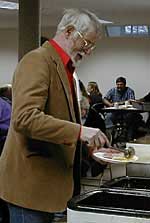All you need is a church and a bar
By Jeff Horwich
Minnesota Public Radio
December 10, 2001
|
| RealAudio |
To get at the heart of small-town Minnesota, peel away the elements of a typical main street. Forget any retail shops or electric traffic signals. Take away the cafe, the grocery store, the school - even the grain elevator. By this point you're probably left with a pretty small town. But chances are you're also left with two pillars of rural Minnesota life - the local church and the local bar. We visited a typical Stearns county town that has just one of each - a church, a bar, and not much else.
| |
|
|
|
||
They say there's a thin line between Saturday night and Sunday morning. Usually it's just a figure of speech. But to get from Saturday night to Sunday morning in St. Anthony, Minn., you just walk across the street.
The sign on the road into town says 77 people live here - the census says 90. In any case, it's small. The first thing you're likely to spot in town is the spire of St. Anthony's Catholic Church.
But on a winter Saturday night the church sits yellow and lifeless at the end of the graveyard. The nighttime action in St. Anthony is 100 yards away in a building with a somewhat lower profile - Schiffler's Bar.
Erv Schiffler has been behind the bar for 45 years. He's not positive, but he thinks he may have the oldest liquor license in the state. He and his father kept the bar running all these years while the rest of Main Street St. Anthony disintegrated.
"There used to be a blacksmith. That closed. There used to be a grocery store and a creamery - everything's closed up. Just the bar," says Schiffler.
It's safe to say Schiffler's is important to the town. The street lights stay lit thanks to Erv's liquor license and property taxes.
"We're here all alone. And there are a lot of towns like us," Schiffler says. "I do a lot of driving around and see a lot of towns and all there is is a bar left. Everything else is closed up. The bars seem to survive."
On big nights like this the bar is a binding force. It keeps people tied to St. Anthony, keeping the community alive. Take Al Zeis.
Zeis says he was born in a log house just down the road. He made his fortune in construction - he travels around the globe and flies his own plane. He keeps a home in the Twin Cities, but on the weekends he says he's right back here with "the best people in the world."
| |
|
|
|
||
"Just look here tonight. These are real people here. You're not going to BS any of these people here. They work hard. I mean, look at their clothes, look at their hands," says Zeis.
Schiffler's bar benefits as an honorary member of many extended families. A bartender says people tend to gather in their "clans." Many huddle with their wives, their cousins, their brothers. They continue to come here because their parents, their uncles, and their aunts came here.
Randy Klasen lives in town and works for the telephone co-op. He calls on a local phrase to describe this family phenomenon.
"Stearns County Syndrome! Now we say it as a joke," says Klasen.
Years ago the term "Stearns County Syndrome" carried connotations of inbreeding. But now it's truly a joke. Locals use it to poke fun at their own close networks of extended families. A local bar like Schiffler's in St. Anthony becomes a family gathering place and thrives on family tradition.
Erv Schiffler chalks up some of his staying power to his own family legacy.
"The Schiffler name has been here forever. My dad was a really great guy and a lot of people knew him, and it's more like we're bringing people in because they know us, and we try and treat people fair. The bar business is pretty rough right now. You've gotta work hard to make money," Schiffler says.
Family is important for regulars like Bonnie Berscheid. She lives a few miles away now, but has been coming to Schiffler's since her father brought her here as a little girl.
"You know everybody here. I'd never go to a bar in Melrose, because I don't know anybody. Or Albany. You don't seem to get the cops out here as easy," she laughs.
And fewer cops on isolated county roads mean fewer arrests for drunk driving. Other patrons also say small town bars are attractive because they can have a few drinks and it's unlikely they'll be pulled over on the way home.
|
"I lived all over, but I came back. I guess it's the peace and quiet. I'm a bartender and that's one of the hardest jobs because you have people around all the time. Here, I can find peace and quiet when I'm not working."
- Bob Schiffler (Erv's brother), in an article in the Stearns Morrison Enterprise, Dec. 12, 1978 |
But Erv Schiffler says part of why business has been down in recent years is that deputies now patrol the countryside more than they used to. So some folks spend less time out drinking, and less money at bars like Schiffler's.
Still, the last couple months have brought a slight boost.
"My dad always told me that when there's a war, business is going to be very good. People maybe want to drown out their sorrows. We're noticing that right now, that our business went up since the World Trade Center got bombed," he says.
Since Sept. 11, people have sought out places to feel "at home." They found them not just in bars, but in churches around Minnesota as well.
In St. Anthony, the church is the one other place where community asserts itself. On Sunday morning it comes alive.
The parking lot is overflowing onto the surrounding streets. Upstairs, the pews are packed for Mass. People chatter loudly on their way in - though Mass, of course, is not a great place to socialize.
But in the basement there's a church breakfast going on. A big one, the kind that happens just a few times a year.
There are fewer than 100 people in town, but 408 members of the parish. It seems as if just about all of them must have passed through the breakfast line on this morning.
"We got baptized here," says Jim Ramacher, who sits behind a table with his friend Bob Rademacher. "I've been going 62 years, I suppose you could say."
Ramacher and Rademacher are dairy farmers on the outskirts of St. Anthony. Bob's a bachelor farmer like you'd expect to find in this town - which claims inspiration for Lake Wobegon. Like many folks, he's been coming here as long as he can remember.
"It's getting more busy, where people don't have the time to associate with each other except for events like this here, the breakfast," says Rademacher.
| |
|
|
|
||
There's a familiar face behind the big griddle of hash browns across the room. It's Randy Klasen, one of the guys from the bar Saturday night.
"The church plays a pretty important role, I guess, in keeping a small community like St. Anthony together," says Klasen. "You have the larger communities surrounding here, Freeport, Albany - some of the bigger communities have more events going on, but here about the only community events are the church."
They built the first church here 130 years ago, only five years after the first settlers arrived. People return week after week for different reasons than they go to Schiffler's Bar, of course. But like the bar, the church pulls in people from miles around who find a sense of place in St. Anthony.
For Ruth Linn, working hard in the kitchen, the church is the community.
"Oh, absolutely. Without it there wouldn't be a St. Anthony. And we're really struggling to keep it going, too. There's talk of it folding," says Linn.
That talk has to do with church consolidation. The St. Anthony parish may be vibrant and active. The community may be devout. But like much of rural Minnesota, this region suffers from a shortage of priests. St. Anthony already shares its priest with two neighboring communities. A new plan by the St. Cloud Diocese calls for more consolidation.
St. Anthony is not due to be phased out. But Ruth worries St. Anthony would be a very different place if there are big changes in the usual church services that bring people together.
"I would hate to think," says Ruth Linn. "I would say that we would pretty much separate, wouldn't we? I don't think the town itself would fold, but the fellowship and the neighbors...."
St. Anthony is special because it's so typical. Even in larger towns the local bar and the local church are often at the center of things.
Over the years it seems shopping, eating, and working can evidently be done somewhere else. But so far the church and bar remain main street's survivors. After all, they depend on family and familiarity as much as on drinks and donations. And family and familiarity are two things you can't always get in the big city.
More Information


